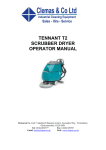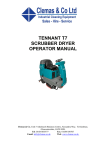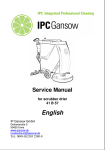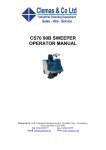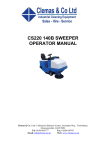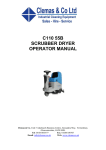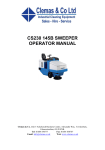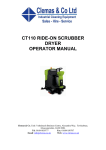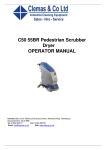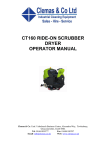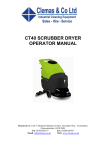Download Operating Instructions
Transcript
Operating Instructions FOR SCRUBBER DRIER MODELS 31-41-61-71-91-101-121-131 B/BF Clemas & Co. Unit 5 Ashchurch Business Centre, Alexandra Way, Tewkesbury, Gloucestershire, GL20 8NB. Tel: 01684 850777 Fax: 01684 850707 Web: www.clemas.co.uk Email: [email protected] ENGLISH 1 INDEX: 1. IMPORTANT WARNINGS…………………………………… 2. INSTRUCTIONS BEFORE OPERATING…………………… 5 3. PRACTICAL GUIDE FOR THE OPERATOR……………… 6 4. INSTRUCTIONS…………………….…………………….… 8 5. TROUBLESHOOTING…………………….………………… 12 6. CLEANING AND MAINTENANCE…………………….…… 15 7. OPTIONAL ACCESSORIES…………………….…………… 16 8. CE CONFORMITY DECLARATION………..…….………… 17 9. TECHNICAL SPECIFICATION…………………….………… 22 3 SPECIAL INFORMATION FOR 10. USING THE BATTERIES AND CHARGER………………… 23 CONTROL AND MAINTENANCE 11. OPERATIONS…………………….…………………….…… 2 ENGLISH 27 1. IMPORTANT WARNINGS: 1.1. IMPORTANT! This appliance is not suitable for removing dusts hazardous to health. 1.2. IMPORTANT! This appliance is not suitable for washing carpet or textile floors or wood floors not treated with non-absorbent resin. 1.3. This appliance is not approved for use on public roads or highways. 1.4. This appliance may only be used by personnel fully trained in its correct and appropriate use. 1.5. In order to prevent unauthorised use of the machine always remove the key from the key switch before leaving the appliance unattended. 1.6. Lower the brushes before leaving the machine unattended to prevent accidental movement. 1.7. When using the machine the operator should take care not to endanger any third persons, particularly children. 1.8. The appliance may not be used on slopes of greater than 2%. 1.9. We expressly draw your attention to the fact that original parts and accessories not supplied directly by Gansow have not been tested or authorised by Gansow. The installation and/or use of such items may therefore adversely affect the efficiency and characteristics of your floor cleaning machine, jeopardising its active and passive safety. The manufacturer declines all liability for damage occurring as a result of the use of non-original parts or accessories. 1.10. Before any cleaning or servicing work is carried out on the machine, the following precautions must be taken: - unplug the plug from the charger from the charger ENGLISH 3 socket; - remove the key from the control panel. ATTENTION ! Before changing the main fuse, disconnect the battery cables from the respective terminals (danger of short circuit). 1.11. Under no circumstances may the charger leads (connecting the charger to the machine) supplied be modified. 1.12. All electrical functions of the machine are interrupted immediately as soon as the plug is plugged into the charger socket. 1.13. This appliance may be used with the brushes provided by the producer only. ATTENTION ! The safety of the appliance will be jeopardised by the use of other brushes. 1.14. *IMPORTANT - battery gas is highly explosive; avoid sparks or open flames close to the batteries! To avoid the build-up of gas inside the machine, the tank and tank lid must remain in the raised position throughout charging. The caps of all battery cells must also be unscrewed and/or removed (not necessary in the case of gel batteries). 1.15. *IMPORTANT - battery acid is corrosive! When topping up with distilled water make sure the level of liquid is the same in all the battery cells. Dry cells shorten battery life and may cause irreparable damage to the entire battery (not relevant to gel batteries). 1.16. IMPORTANT! Rooms where batteries are being charged should always be well ventilated. * Not relevant to maintenance free gel batteries 4 ENGLISH 2. INSTRUCTIONS BEFORE OPERATING: 2.1. Before operating a battery-powered machine, please read all the following instructions and the instructions for use of the charger (if purchased). 2.2. Note that the batteries deliver maximum power only after eight to ten charging cycles. During this period, the machine should not therefore be used for excessively heavy cleaning. 2.3. To provide your battery with even greater protection, the machine is equipped with a charge indicator and hour counter. By means of variously coloured LEDs (seven yellow and one red), this provides a constant indication of the charge and automatically shuts the brush motors down when the charge drops below the safety level. The LEDs indicate the following stages: YELLOW ON: batteries within the charge limit YELLOW FLASHING 15 seconds of running time remain before the brush motors shut down. RED ON: the battery is flat and the brushes are blocked. You should immediately go to the charging area to avoid damaging the batteries. The transition of one LED to another with a delay of just 15 seconds ensures a prompt response in the event of flat batteries to avoid discharging them further and therefore irreparably reducing their working life. 2.4. IMPORTANT! The machine must not under any circumstances be started up with the front and top lids raised. ENGLISH 5 3. 3.1. PRACTICAL GUIDE FOR THE OPERATOR: *IMPORTANT - Seal the battery cells by screwing on the caps. * Not relevant to maintenance free gel batteries 3.2. After turning the charger off, unplug the connection lead from the charger from the battery socket to power the machine. 3.3. Lift the top lid and use a hose or bucket to fill the clean water tank (on the left) with cold water up to a maximum of 3 cm from the top of the tank (the water should preferably be cold and in any case never hotter than 60°C). IMPORTANT! Use low foam detergent as excessive foam could jeopardise the efficiency and function of the machine. Close the top lid, lifting slightly on the hinge side to make sure it fits perfectly to the tank. IMPORTANT! If the lid does not fit perfectly, there would be no vacuum at the squeegee and therefore no flow-back of liquid to the collection tank (on the right). If necessary, repeat the operation correctly. Avoid resting heavy objects on the lid as this could warp it and prevent it from fitting perfectly to the tank. 3.4. Make sure the cap of the dirty water tank (on the right) drain hose is correctly in place. Perfect closure of the cap is essential to obtain a vacuum in the collection tank and therefore maximum suction power. 3.5. Turn the key switch clockwise to start the machine. 3.6. Light pressure and a slight sideways movement of the pedal release the brushes which are lowered in contact with the ground. 6 ENGLISH 3.7. To activate brush rotation, press the corresponding button on the left side of the control panel. MACHINES WITH DIAPHRAGM: Pressing this button opens the water solenoid valve and turns the water pump on. Turn the knob on the control panel clockwise to adjust the quantity of water to the brushes (from 0 to 7 litres). MACHINES WITHOUT DIAPHRAGM: Pressing this button opens the water solenoid valve. To adjust the quantity of water to the brush in accordance with the dirt to be removed (more dirt=more solution), use the red lever at the bottom on the operator's right. When the lever is horizontal, the cock is fully open, when vertical it is completely closed. 3.8. Lower the squeegee to the ground, using the control lever in front of the operator under the handle. 3.9. Turn on suction to convey the dirty water to the collection tank, using the button marked with a fan on the right of the control panel. ENGLISH 7 4. 4.1. INSTRUCTIONS: SERIES "B" MODELS WITHOUT DRIVE: The appliance is equipped with a patented drive system - as the brush rotates in contact with the ground, it draws the whole machine along at the correct working speed. By pushing slightly, the drive speed can be increased as required. Holding it back slows it down. SERIES "BF" MODELS WITH DRIVE: Push the drive lever gradually forwards to advance the machine at the required speed. The maximum possible speed is 5.5 km/h. On curves, adjust speed by moving the drive lever backwards. When the lever is released completely, the drive motor stops automatically. ATTENTION! The drive unit is fitted with a crush prevention device consisting of a square red button at the centre of the handle which changes the direction of movement if touched while the appliance is in reverse. This prevents the operator being crushed in the event of incorrect manoeuvres. 4.2. Clean in parallel strips overlapping by 3 to 4 cm. Rollers on the ends of the squeegee act as bumpers and also enable you to clean at a tangent to the edges. The extreme manoeuvrability of the squeegee which can be swung freely and widely to both sides enables you to clean around any obstacle. The squeegee then returns to the central position when the obstacle or curve has been passed. When consigning the machine or during a demonstration, our service technician can advise you on the best way of cleaning your own particular floor surface. 8 ENGLISH 4.3. By means of a vacuum created inside the collection tank, the used water and the dirt are completely absorbed and conveyed to the dirty water tank. To prevent dirty water or foam damaging the vacuum motor, the collection tank is protected by two sensors (electrodes) which shut the machine down when the tank is full (they also detect the level of any foam present). 4.4. After finishing the work or when the solution in the tank is used up (indicated with a red flashing light on the switch board), stop brush rotation by pressing the corresponding button. This also stops the flow of water. Raise the head using the pedal. 4.5. To collect the remaining dirt, continue for a further 3-4 metres with suction activated and the squeegee lowered, than turn both functions off by pressing the suction button and raising the squeegee lever. This empties all water left in the circuit into the collection tank. IMPORTANT! After you have finished cleaning, you are recommended to raise the tank lid and turn the suction motor on again for a few minutes. The dry air sucked in will evaporate any remaining moisture, extending the working life of the motor. 4.6. Empty the collection tank into a container or drain using the black drain hose and proceeding as follows: - detach the hose from the control panel; keeping the hose raised above the level of the tank at all times, remove the cap; - lower the hose gradually towards the container. 4.7. IMPORTANT! After each cleaning session, you are recommended to drain the dirty water and rinse the tank to avoid unpleasant smells or the formation of harmful germs. To make this operation faster, simpler and more effective, the appliance is fitted with an exclusive system: - the tank tilts backwards, after raising the lid, lift the tank until it rests ENGLISH 9 - on the chassis (empty before tilting); after removing the cap, lower the drain hose to allow the water to run off rapidly; wash the collection tank with running water; - leave the tank tilted until the next time you use the machine. - The appliance has been designed to facilitate thorough maintenance. A little attention improves the efficiency of your appliance and extends the already long working life. 4.8. When parking the machine, you are recommended to lower the brush head to anchor it to the ground. 4.9. The machine has a rapid brush replacement system: 1- turn the key to the off position (anticlockwise as far as it will go), 2- use the pedal to lift the brush head, 3- hold the brush with both hands and turn it sharply in the normal direction of rotation. In the case of heads with two motors, the direction of rotation is always towards the centre of the head. Hold the bayonet coupling firmly in position and release the brush. 4- remove the brush and position the replacement in the centre of the housing, precisely under the bayonet coupling, 5- use the pedal to raise the brush head, 6- switch the appliance on and activate brush rotation for a few moments, then turn off again, 7- finally, raise the brush head and make sure the brush is correctly fitted. If necessary, repeat operations 1 to 6. 4.10. The key switch should be turned off before recharging the batteries. 4.11. In order to avoid any build-up of gas inside the machine, the tank (previously emptied) covering the batteries must be raised and remain in that position throughout charging. Similarly, the caps of all battery cells must also be unscrewed and/or removed (not necessary in the case of maintenance-free gel batteries). 10 ENGLISH PRECAUTIONS Battery gas is highly explosive. Avoid sparks and open flames near the batteries. When topping up with distilled water make sure the level of liquid is the same in all the battery cells. Dry cells shorten battery life and may cause irreparable damage to the entire battery (not relevant to maintenance-free gel batteries). ATTENTION! If the battery is damaged, the acid is highly corrosive! 4.12. IMPORTANT! Rooms where batteries are being charged should always be well ventilated. Before using battery-powered models, read carefully the instructions on use and maintenance of the machine, batteries and charger; procedures and precautions to be observed while charging batteries and connecting the charger and inspection and maintenance of batteries and maintenance schedules. ENGLISH 11 5. TROUBLESHOOTING: 5.1. No water is delivered, check that: - 5.2. the brush is moving, if necessary, activate the brush by using the button on the left of the control panel, there is water in the tank and the level is above the filter (the red LED on the switch board is flashing), if necessary, top up and add detergent, the clean water filter is not clogged, if necessary, remove and clean with air from the outside inwards, the water solenoid valve is operating correctly, if necessary, remove and clean, the water cock is open (lever horizontal = fully open, lever vertical = fully closed), the knob on the control panel (diaphragm machines only) is not on zero. The water flow does not stop: - close the water cock, then remove the solenoid valve and thoroughly clean the inside, including the closure spring housing, - open the cock again and check it works, - replace the valve if necessary. 5.3. The suction motor does not start: - reset by using the key switch to turn the appliance off then on again, - clean the collection tank around the sensor electrodes and the electrodes themselves. ATTENTION! Do not move the electrodes from their original position. Make sure they are not already out of position. By modifying the distance between them, or between the electrodes and the side of the tank, the power cut-off mechanism may be activated by mistake. Contact the Gansow Distributor Technical Assistance Service if necessary. 12 ENGLISH - check the main fuse. - check the charge of the batteries and if necessary, charge. 5.4. Water is not sucked up, although the motor is operating; - - 5.5. make sure the cap is correctly in place on the drain hose. make sure the suction hose between the squeegee and the dirty water tank is not blocked. If necessary unblock and fix the hose well to both connecting pieces. make sure the top lid is correctly in place on the tank, raise and lower as described in point 3.3, check the batteries are not flat. The squeegee leaves wet marks or stripes: - - clean the blades of the squeegee and remove any trapped grit or paper, check the wear of the squeegee blades and if necessary, turn or replace, PARABOLIC SQUEEGEE: make sure that when moving forwards with suction on, the squeegee is perfectly horizontal. If necessary, adjust the central nuts. carry out the checks described in point 5.4. IMPORTANT! When dealing with large amounts of fluff, this may accumulate under the rear squeegee blade causing leakage and therefore preventing perfect drying. If this occurs, the squeegee should be raised while at the same time moving the machine backwards to pick up the dirt left on the ground, proceeding in a diagonal direction. 5.6. The squeegee sticks to the floor due to strong suction: - - check the state of the front blade and in particular the inlet slits. If obstructed or worn, clean or enlarge them slightly, or cut one to three additional slits until the squeegee functions correctly, turn round or replace excessively worn squeegee blades. They can be reversed to extend the working life, STRAIGHT SQUEEGEE: adjust pressure on the ground using the ENGLISH 13 - 5.7. screw on the mobile support, tightening lightens the pressure, unscrewing increases pressure. PARABOLIC SQUEEGEE: adjust pressure on the ground by tightening the adjustment nuts above the levelling wheels on the back of the squeegee. The brush motor shuts down: - 5.8. the automatic battery protection device has tripped. Stop working and recharge the batteries immediately. The dirty water does not drain out through the hose: - make sure the tank is not blocked near the drain outlet. - remove any blockages in the drain hose itself. 5.9. The machine leaves a smeary mark: - no water flow, no solution in the tank (fill the tank), or solution tank filter dirty (clean filter), check the brush feed pipe which could be blocked, open the water cock if closed. carry out the additional checks described in point 5.1. 5.10. The machine does not move forward or moves forward too slowly (BF SERIES MODELS WITH DRIVE ONLY) - check and remove any oxidation on the battery terminals, then tighten, the squeegee is stuck to the ground by excessive suction. See point 5.6. - the batteries are flat, stop work and recharge. 14 ENGLISH 6. SERVICE AND MAINTENANCE: 6.1. Before any servicing or maintenance work is carried out on the machine and before any parts are replaced: - drain both tanks completely, unplug the plug from the charger from the charger socket, - turn off the key switch. 6.2. The electrodes in the dirty water tank should always be kept clean and in their original position. By modifying the distance between them, or between the electrodes and the tank, the power cut-off mechanism may not activate correctly. 6.3. Clean the dirty water tank thoroughly and regularly to prevent the formation of unpleasant odours and bacteria. Tilt the tank to facilitate cleaning. 6.4. The tank lid should always be left open between cleaning sessions to enable the internal surface to dry out. Never place heavy objects on the top lid as this could warp it. 6.5. After each cleaning session, clean the outside of the machine to remove any chemical residues which could accelerate wear and affect the appearance of the materials. 6.6. The filter in the clean water tank should be cleaned regularly twice a week. 6.7. Check the state of the squeegee blades regularly and if necessary turn them over or replace them. See also sections 5.5. and 5.6. 6.8. Perform battery maintenance regularly to maintain their efficiency and extend their working life. They are expensive and should be kept in good condition. ENGLISH 15 6.9. The outlet slits on the suction motor should be checked and cleaned regularly, especially where there is a considerable amount of fluff in the atmosphere. 6.10. A general control by authorised Gansow personnel is recommended at least once every six months. 7. OPTIONAL ACCESSORIES: 7.1. Depending on the type of floor and dirt, you may want to use brushes other than those supplied as standard. The following are available from your Gansow Distributor: - 7.2. Black soft and PES brushes for delicate floors (gyms, sealed wood, etc); in polycarbonate of various hardnesses for a more energetic and deep treatment. As an alternative to the brushes, you can use a pad, available in three versions with different colours: - black = abrasive red/green/purple = medium hard - brown/yellow/white = soft. The brush does not need to be removed to use the pad, which can be fitted directly to the brush itself. Alternatively, a special pad holder can be provided. 16 ENGLISH 8. TECHNICAL SPECIFICATION: 31 B 46/50 41 B/BF 53/57 61 B/BF 53/57 Cleaning width mm 460/500 530/570 Squeegee width mm 870 870 530/570 870 Capacity per hour theor. m²/h 1840 2120/2930 2120/2930 Maximum speed km/h 4 4/5,5 4/5,5 Number of brushes no. 1 1 1 Brush diameter mm 460 533 533 kg 24 31.5 31.5 g/cm2 110 109 109 rpm 180 200 200 W 600 650 650 - Mechanical B : MECHANICAL BF : ELECTRONIC B : MECHANICAL BF : ELECTRONIC Nominal drive motor power W / B:/ BF : 200 B:/ BF : 200 Suction motor power W 350 410 550 dB(A) 83 83 83 Solution tank l 26 40 62 Collection tank l 26 40 62 Diaphragm / - - Yes Drive wheel diameter mm 160 230 230 Pivoting wheel diameter mm 125 125 125 kg 100 no. 2 B : 129 BF : 142 2 B : 135 BF : 148 2 V 24 24 24 cm X/Y/Z 124x51x95 128,5x60,5x108,5 143x60,5x108,5 128,5x60,5x113 143x60,5x113 Max. brush pressure Pressure of brush head on the ground Brush rotation speed Brush motor power Drive Sound pressure Net weight without batteries Number of batteries Voltage of batteries in series Machine size ENGLISH 17 Total oscillation value 18 ENGLISH m/s² <2,5 <2,5 <2,5 TECHNICAL SPECIFICATION: 61 B/BF 65/68 71 BF 70/72 71 BF 85 Cleaning width mm 650/680 700/720 850 Squeegee width mm 1000 1000 1150 Capacity per hour theor. m²/h 2120/2930 3850 4675 Maximum speed km/h 4/5,5 5,5 5,5 Number of brushes no. 2 2 2 Brush diameter mm 345 370 430 kg 31,5 40 45 g/cm2 125 156 135 rpm 180 180 180 W 250 400 400 - B : MECHANICAL BF : ELECTRONIC Nominal drive motor power W B:/ BF : 200 400 400 Suction motor power W 550 550 550 dB(A) 83 82 82 Solution tank l 62 70 70 Collection tank l 62 70 70 Diaphragm / Yes - - Drive wheel diameter mm 230 230 230 Pivoting wheel diameter mm 125 160 160 Net weight without batteries kg B : 137 BF : 150 185 187 Number of batteries no. 2 4 4 V 24 24 24 Max. brush pressure Pressure of brush head on the ground Brush rotation speed Brush motor power Drive Sound pressure Voltage of batteries in series 19 ENGLISH ELECTRONIC ELECTRONIC TECHNICAL SPECIFICATION: Machine size cm X/Y/Z 124x69x113 139x69x113 163x76x111 167x86x111 Total oscillation value m/s² <2,5 <2,5 <2,5 91 BF 70/72 91 BF 85 101 BF 70/72 Cleaning width mm 700/720 850 700/720 Squeegee width mm 1000 1150 1000 Capacity per hour theor. m²/h 3850 4675 3850 Maximum speed km/h 5,5 5,5 5,5 Number of brushes no. 2 2 2 Brush diameter mm 370 430 370 kg 40 45 40 g/cm2 156 135 156 rpm 180 180 180 W 400 400 400 - ELECTRONIC ELECTRONIC ELECTRONIC Nominal drive motor power W 400 400 400 Suction motor power W 550 550 550 dB(A) 82 82 85 Max. brush pressure Pressure of brush head on the ground Brush rotation speed Brush motor power Drive Sound pressure 20 ENGLISH TECHNICAL SPECIFICATION: Solution tank l 90 90 100 Collection tank l 90 90 100 Diaphragm / Yes Yes Yes Drive wheel diameter mm 230 230 230 Pivoting wheel diameter mm 125 125 160 Net weight without batteries kg 169 171 179 Number of batteries no. 4 4 4 V 24 24 24 Machine size cm X/Y/Z 139x76x113 139x86x113 163x76x115,5 Total oscillation value m/s² <2,5 <2,5 <2,5 101 BF 85 121 BF 70/72 121 BF 85 Voltage of batteries in series Cleaning width mm 850 700/720 850 Squeegee width mm 1150 1000 1150 Capacity per hour theor. m²/h 4675 3850 4675 Maximum speed km/h 5,5 5,5 5,5 no. 2 2 2 Number of brushes ENGLISH 21 TECHNICAL SPECIFICATION: Brush diameter mm 430 370 430 kg 45 40 45 g/cm2 135 156 135 rpm 180 180 180 W 400 400 400 - ELECTRONIC ELECTRONIC ELECTRONIC Nominal drive motor power W 400 400 400 Suction motor power W 550 550 550 dB(A) 85 82 82 Solution tank l 100 120 120 Collection tank l 100 120 120 Diaphragm / Yes Yes Yes Drive wheel diameter mm 230 230 230 Pivoting wheel diameter mm 160 160 160 Net weight without batteries kg 181 194 196 Number of batteries no. 4 4 4 V 24 24 24 Machine size cm X/Y/Z 167x86x115,5 163x76x115,5 167x86x115,5 Total oscillation value m/s² <2,5 <2,5 <2,5 Max. brush pressure Pressure of brush head on the ground Brush rotation speed Brush motor power Drive Sound pressure Voltage of batteries in series 22 ENGLISH TECHNICAL SPECIFICATION: 101 BF 70/72 S 101 BF 85 S 131 BF 100 S Cleaning width mm 700/720 850 1000 Squeegee width mm 1000 1150 1150 Capacity per hour theor. m²/h 3850 4675 5500 Maximum speed km/h 5,5 5,5 5,5 Number of brushes no. 2 2 2 Brush diameter mm 370 430 370 kg 40 45 54 g/cm2 270 225 240 rpm 180 180 180 W 600 600 600 - ELECTRONIC ELECTRONIC ELECTRONIC Nominal drive motor power W 850 850 1100 Suction motor power W 550 550 660 dB(A) 83 83 85 Solution tank l 100 100 130 Collection tank l 100 100 130 Diaphragm / Yes Yes Yes Drive wheel diameter mm 250 250 250 Pivoting wheel diameter mm 160 160 160 Max. brush pressure Pressure of brush head on the ground Brush rotation speed Brush motor power Drive Sound pressure ENGLISH 23 TECHNICAL SPECIFICATION: Net weight without batteries kg 212 221 268 Number of batteries no. 4 4 6 V 24 24 36 Machine size cm X/Y/Z 163x76x115,5 167x86x115,5 168x102x115,5 Total oscillation value m/s² <2,5 <2,5 <2,5 Voltage of batteries in series 24 ENGLISH 9. CE CONFORMITY DECLARATION We hereby declare that the machine described below complies with the relevant basic safety and health requirements of the EU Directives, both in its basic design and construction as well as in the version put into circulation by us. This declaration shall cease to be valid if the machine is modified without our prior approval. Product: Floor cleaner Type: Premium Green Line Relevant EU Directives 2006/42/CE 2004/108/CE 2000/14/CE Applied harmonized standards EN 50106:2009-07-01 EN 55014-1: 2007-06 Applied national standards DIN EN 60335-1: 2007-02 DIN EN 60335-2-72 DIN EN 60529: 1991 + A1: 2000 25 ENGLISH 10. SPECIAL INFORMATION FOR USING THE BATTERIES AND CHARGER Do you know how much a set of batteries costs? Between about 650 and 2000 € according to the size of your machine. Should you have armoured tube batteries, the cost of a set is between 2500 and 2100 €. Reason enough, we think, to give these expensive energy units the necessary daily attention required, in order to achieve the greatest possible working life from them. To ensure even greater protection for your batteries, we stock a battery condition indicator which shows the state of the battery at any given time. This instrument (type: BEM) is a panel type and can be fitted in the panel on any of our battery-powered machines. Luminous diodes of various colours are used to indicate the different levels of voltage. The device can also be used to switch the brush motor(s) off automatically as soon as the battery reaches an fix state of discharge. Please feel free to consult the staff at our local sales depots or dealers for information on using and fitting these instruments as well as on the way they work. Points you really must take notice of: - Never discharge the batteries too low. Every battery should only be discharged to 70 or 80% of its rated capacity. You will overburden the batteries, a) if you use your machine too long, too often. How long you can safely work your machine, will be explained to you, when our service personnel installs your equipment. You can ask our service personnel at any time, or call our nearest service depot. For machines fitted with a BEM the brushes will automatically be switched off when the battery voltages becomes too low. 26 ENGLISH b) if you use your machine regularly more than once within 24 hours to a certain extend. A good battery charger requires continuously approx. 10 - 12 hours (according to type) to recharge empty batteries. If you interrupt the charging process, the batteries will never become fully charged, and will be quickly ruined. c) if you do not recharge the batteries immediately after having used them to about 70 or 80% of their rated capacity. Empty batteries do not have the power for a further operation, and will be quickly ruined. For machines fitted with a BEM the brushes will automatically be switched off when the battery voltages becomes too low. If you use your machine daily for (a) short period(s) only, ask at your nearest agency, or our service personnel. We will inform you as to the most practical way to use your charger to avoid premature corrosion of the battery. - Storage of batteries f batteries are taken out of service for a lengthy period they should be stored fully charged in a dry, frost-free room. To ensure the battery is always ready for use a choice of charging methods can be made: a) A quarterly full charge. If loads are connected, e.g. BEM, a full charge could be needed after 3 weeks. b) Float charging at the instructed charging voltage. - Correct connection of the battery charger. Please take careful note that: ENGLISH 27 d) e) f) the plug of the charger cable is firmly plugged into the machine; the mains plug is firmly fitted into the wall socket. Confirm that the wall socket has electrical feed overnight and hang a notice on the plug, saying, that during the charging period the plug, must not be removed; the battery charger will switch itself on automatically after 15 seconds. Before leaving the machine, please check carefully, that all connections are properly made and that the charger is switched on. Many batteries have been damaged prematurely because something has been overlooked. Please read the operating instructions of the type of charger in use with you. - Secure seating of the post terminals on the cables, that join the batteries together. Loose battery post terminals are dangerous because a layer builds up that hinders the flow of electricity. When recharging the batteries, full electrical charge cannot flow, the batteries will not become fully charged and are therefore damaged prematurely. Should you find loose post terminals, please do not simply tighten them, but remove them, clean the post and the terminal inside and out, smear with battery grease and refit tightly. - Run-in instruction Note that brand-new batteries need a running-in period and thus can not yet supply full power during the first 8 - 10 discharges. Therefore, the machine should be kept off heavy duty jobs during that time. Should you have any further questions about the handling of your battery machine, please call our nearest office or agency. - *Never let the batteries get dry. 28 ENGLISH The electrolyte must cover the cell plates at all times, it should be at least 5/8 ths of an inch over the plates. Cell plates that are continuously dry or part dry, build up a layer that prevents the cells from charging, rendering the battery useless within a short time. - *Never overfill the batteries. Too much electrolyte is as bad as too less. Only top up to approx. 5/8 ths of an inch above the cell plates. Important in breaching with battery acid - corrosive! - *Always top up the batteries with distilled water, never acid. The only thing that vaporises when the batteries are warm, is the distilled water, therefore it is only necessary to top up with distilled water. Topping up with acid, makes the electrolyte too strong, and causes corrosion on the cell plates. Important in breaching with battery acid - corrosive! *this does not apply to maintenance-free batteries - *Never top up with tap water. Tap water has an electrical conductivity and will destroy the batteries. You can purchase distilled water at Electrical Wholesalers, from us, or from Petrol Stations. If you have any further questions about the handling of our battery machines then please contact your nearest Gansow representative or our head quarter in Unna / Germany. *this does not apply to maintenance-free batteries ENGLISH 29 11. CONTROL AND MAINTENANCE OPERATIONS: IMPORTANT! Repairs should preferably be performed by qualified personnel. Only original spare-parts may be used. Modification of the machine without the approval of the manufacturer or the use of unauthorised materials invalidates the warranty as the structural condition of the machine may differ from that described in the certificate After any repair work by unauthorised personnel the machine must be officially approved by Gansow or a technician authorised by the company to confirm conformity with the original conditions and therefore the validity of the general terms of the warranty. Before any cleaning or servicing work is carried out on the machine, disconnect the charger cable and remove the key from the key switch to guarantee operator safety. IMPORTANT SAFEGUARDS The following tasks should be carried out daily before or after each work session: - remove dirty water and rinse out the tank, clean the machine (do not use water jets or water cleaners) rinse the suction hose by running water from inside the tank, charge battery and check that the battery terminals and power plug are securely in position - clean the electrodes and check the level of the dirty water and foam, make sure the tank lid fits correctly to the tank. 30 ENGLISH Table of recommended checks, inspections and maintenance and schedule, based on daily use of about four hours; Description of control interval interval interval interval interval WK.LY MTH.LY 4/MTH 6/MTH YR.LY 1. General controls Check the fixing and condition of the brush X X Check for water leaks from the tanks Clean the solution tank filters X Make sure the switches and indicator lights on the panel are working correctly Check that the squeegee blades are not worn or damaged Check that the squeegee is correctly adjusted and adheres to the ground when suction is activated Grease the head raising and squeegee lever rotation pins Make sure there are no foreign bodies in the drive wheels and check the tyres are not worn 2. Motors X X X X X Check, if possible, wear of the drive motor carbon brushes and replace if necessary Check wear of the brush motor carbon brushes and replace if necessary (battery powered models only) Check wear of the suction motor carbon brushes and replace if necessary 3. Drive X Ensure cables are not damaged or loose X X X ENGLISH 31 Description of controls interval interval interval interval interval WK.LY MTH.LY 4/MTH 6/MTH YR.LY 4. Collection tank Make sure the drain hoses are not blocked X X Make sure the suction hose is not blocked 5. Batteries Check the condition of the cables and the seal of the cell caps. If the machine is not used and the batteries are active, recharge every three months Top up the level of battery fluid in all cells. (not necessary with gel batteries) Grease the battery terminals (not necessary with gel batteries). Call the authorised Gansow technical assistance service for a full control 32 ENGLISH X X X X X


































